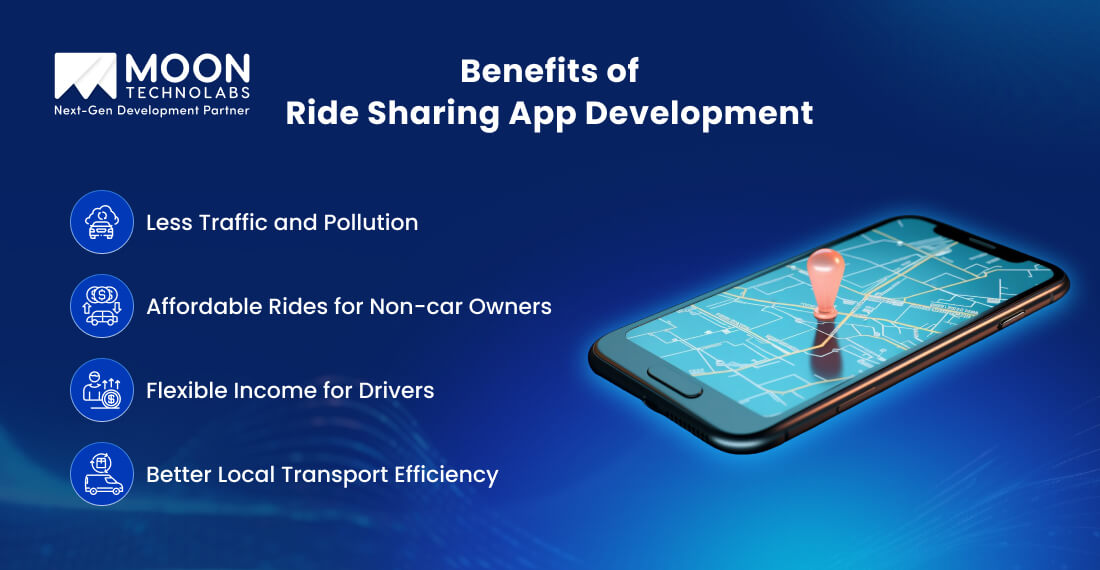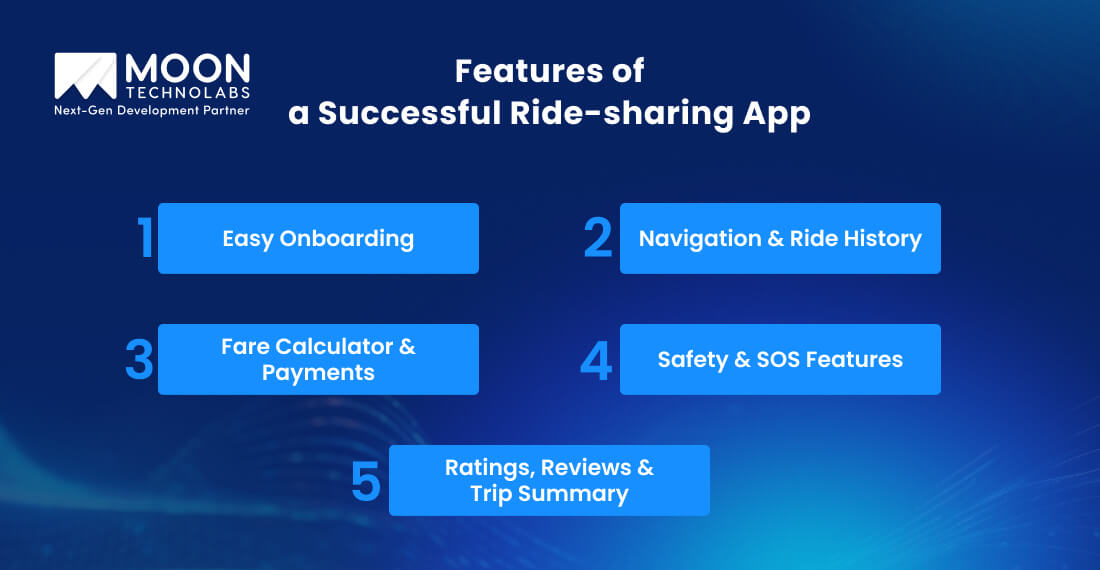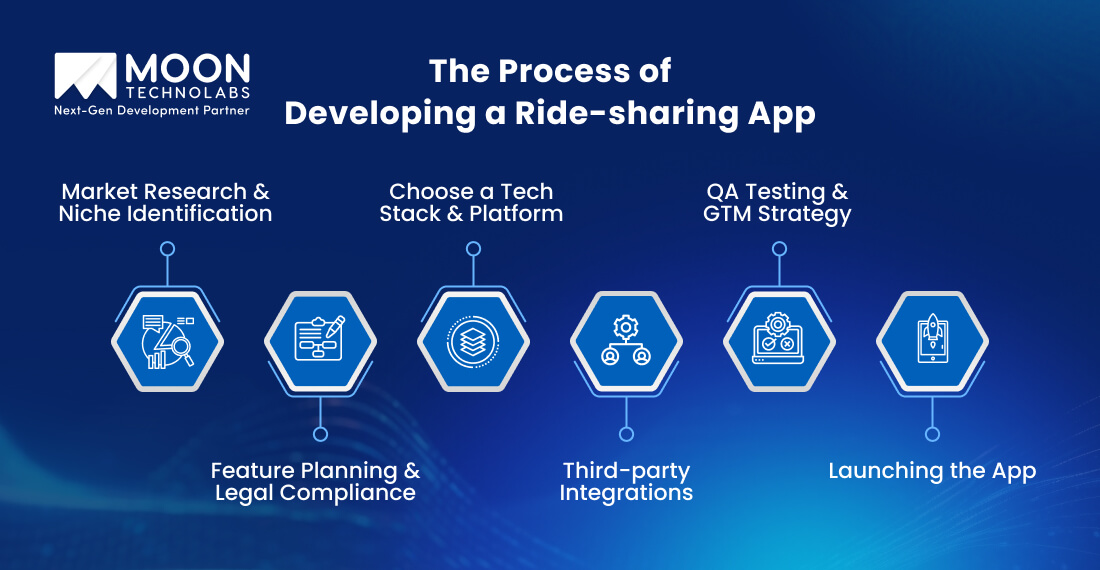Table of Content
Blog Summary:
Planning to develop a ride-sharing app but not sure how to proceed? You are in the right place to get the relevant information. In this blog, we discuss the detailed process of a Ride Sharing App Development, along with other details like its function, benefits, features, development cost, and reasons to invest.
Table of Content
With Uber and Lyft soaring popularity, on-demand transportation services are booming. A report by Research and Markets suggests that the on-demand home services market is likely to grow by USD 15.11 trillion from 2023 to 2028, increasing by a CAGR of 68.02% during this period.
So, if you are seeking Ride Sharing App Development, you have made a decisive step. Building a ride-sharing app lets you grab huge revenue generation opportunities and thus makes your investment worthwhile. However, you need to build a robust app integrated with the right features and functionalities to lead the competitive market.
In this blog, we will discuss everything about ride-sharing app development to help you make the most powerful app.
Ride-sharing apps are digital platforms that facilitate passengers’ connections with drivers for on-demand transportation and convenience. Their main purpose is to minimize the necessity of private car ownership.
Besides, they also contribute a lot to minimizing traffic congestion. In terms of cost-effectiveness, ride-sharing apps emerge as a good option for traditional taxis.
There are three varieties of ride-sharing models: Peer-to-Peer (P2P), Business-to-Consumer (B2C), and carpooling.
Of course, the COVID-19 pandemic adversely impacted the growth of this industry. It minimized demand and thus also increased health concerns. However, post-pandemic recovery has been impeccable, with enhanced safety measures, return to travel, etc.
Ride-sharing apps offer numerous lucrative logistics opportunities for businesses and entrepreneurs. They also provide a greater opportunity for white-label app development, electric vehicle integration, and other related activities, making them an emerging and attractive sector for investment and innovation.
Ride-sharing apps serve their core purpose of letting users book rides smoothly and conveniently. Let’s understand how they work and how they serve users:
Users should download and install the app first on their devices. After doing it successfully, they register with the app by providing the following necessary details;
Once they do it successfully, users can access the app, enter their pickup/drop-off locations, and request a ride. .
The app leverages GPS to pinpoint users’ locations and scans for many nearby drivers. When users make a ride request, an algorithm starts matching riders with nearby available drivers. It optimizes travel time and thus minimizes wait.
After selecting the driver, the app offers a fare estimate before confirming the ride. The app does this based on numerous factors like traffic, distance, and demand. Users can pay conveniently with integrated gateways using digital wallets, credit/debit cards, app-specific credits, and more.
After matching properly, users can easily track the driver’s real-time location and ETA through a live map. Both parties have the option to analyze the route throughout the trip.
Once the ride is completed, passengers have the option to rate drivers and leave feedback. This rating system helps maintain service quality and also ensures full accountability on both sides.
Investment in taxi booking app development is a good decision when seeking to grab earning and growth opportunities in this sector. Let’s understand several reasons why you need to invest in ride-sharing app development;
The growing global attention to urbanization has increased the necessity for flexible and efficient transportation solutions. Lately, consumers have focused on ride-sharing compared to personal vehicle ownership, mainly due to its convenience and affordability.
Getting an app-based solution provides an appropriate platform to meet the increasing demand. It also offers seamless payments, real-time ride-matching, and scalable operations.
Though ride-sharing is already popular in metropolitan areas, it’s gradually becoming popular in Tier 2 and Tier 3 cities, along with remote areas. Indeed, this presents a largely untapped market. These areas don’t have adequate public transport, which creates a huge demand for those with many alternative mobility options.
Localized ride-sharing apps developed to match specific location requirements can easily address these voids. They also create vast employment opportunities for local drivers and add a vast community-driven business appeal.
Since ride-sharing apps are scalable, they allow you to expand your business easily in the future. Whether you wish to start with an individual city or seek to expand nationally, the core infrastructure of the app supports fast growth. In addition, monetization opportunities are also diverse with ride-sharing apps.
These apps can generate vast revenue in several ways, such as subscription models, driver commission, in-app purchases, and surge pricing. Integration with logistics or food delivery services also adds various revenue opportunities.
Nowadays, most governments promote digital mobility solutions to minimize traffic congestion and carbon emissions. Ride-sharing apps are available with various regulatory incentives, such as startup grants, tax breaks, or smart city partnerships. Integrating features like bike-sharing, public transit, and EV infrastructure can easily make your app future-proof.
We help you create scalable, quick, and fully tailored transportation apps that match your brand’s specific needs and dominate the market.

Creating a ride-sharing application provides a range of advantages that go beyond for users. It contributes effectively to environmental sustainability, urban mobility, and various economic opportunities. Let’s explore several important advantages of car booking app development.
Ride-sharing apps optimize vehicle usage by connecting many passengers to a single ride. Thus, the number of vehicles on the road is minimized. Fewer cars mean less traffic congestion, even during peak hours.
It also minimizes the emission of greenhouse gases and air pollutants, effectively contributing to cleaner air and a fully sustainable urban environment.
Being a reliable and cost-effective option, ride-sharing apps are apt for individuals who don’t own a car for any reason, be it financial, lifestyle, or others. These apps emerge as reliable transportation options for them, especially compared to traditional options.
Be it flexible pricing, ride-pooling, or accessing different vehicles, these platforms are available with several things. It comes with a vast accessibility of mobility even without an increased ownership cost.
Ride-sharing apps bring a plethora of earning opportunities for drivers on their terms. It provides drivers a higher flexibility to work and earn based on their availability, location, time, etc. Whether it’s students, retirees, or anyone looking for part-time earnings, they can simply find the best option for part-time income.
Ride-sharing applications are not only limited to moving people; they also redefine the logistics of various products and services. Many platforms integrate with different delivery systems.
These support local businesses and thus boost their overall efficiency when transporting groceries, packages, and other essentials. This versatility helps minimize delays and makes the urban supply chain more responsive.

Ride-sharing apps are packed with numerous features to connect riders with drivers while focusing on transparency, safety, and convenience. Let’s explore some of its important features;
A streamlined onboarding process is necessary. Riders should have the ability to sign up fast with the use of phone numbers, emails, social media accounts, and more. For drivers, they should have various documents – including vehicle registration, driver’s license, insurance, and more. Be it walkthroughs or in-app tutorials, they guide both drivers and users through their first interaction with the platform.
You Might Also Like:
Many drivers find real-time GPS-based navigation useful for reaching their destinations more efficiently. It enables riders to track routes live. Meanwhile, accurate mapping minimizes any delay and improves reliability.
In addition, maintaining a detailed ride history allows users to review those of many past trips, rebook previous routes, check fare details, etc. These add a complete layer of transparency and convenience.
A fare calculator is another quite essential feature for any ride-sharing app. It calculates the overall ride costs based on numerous factors such as distance, time, demand surcharges, tolls, etc.
These factors are pivotal when it comes to calculating costs with a higher accuracy. Besides, the integration of various payment options is also necessary for higher flexibility with improved satisfaction. These payment options include cards, digital wallets, and others.
Safety should never be compromised. An in-app SOS button needs to connect riders directly to emergency services or many pre-selected emergency contacts.
Besides, features such as real-time ride tracking, shared with those of driver identity verification, trusted contracts, and vehicle information display indeed promote user trust. They also emphasize safety throughout the entire journey.
With this feature, users can leave their feedback after the completion of their ride. It reflects the service quality as well as problematic behavior. Many factors play a vital role in maintaining a higher transparency and thus improve user confidence. These factors are detailed trip summary, route, fare, driver information, and more.

Building a ride-sharing app is a process that includes multiple steps for different purposes. The following are all the steps that are required to develop a robust app;
You Might Also Like:
Thorough market research is essential before developing an on-demand transportation app. The process includes analyzing competitors such as Lyft, Uber, and local services. It provides details of their strengths and weaknesses, and finding a niche, be it women-only drivers, eco-friendly rides, or rural area coverage.
These factors play a vital role in making your ride-sharing app stand out. Besides, it’s pivotal to gather pain points and customer expectations to craft features that resonate well with your target customers.
The next step involves deciding the main and cutting-edge features. Core features generally include GPS tracking, user registration, driver-passenger communication, fare estimation, payment integration, and more.
Advanced features include loyalty programs, ride scheduling, AI-based route optimization, and more. Complying with licensing, local transportation laws, data protection regulations, and more is also non-negotiable.
Choosing the right platform and technology is quite necessary when it comes to vehicle booking app development. It also has a direct impact on scalability, performance, and maintenance. Let’s find out some of the top stacks as follows;
For Frontend
Backend
Database
Cloud and Hosting
You need to make the final decision between a native or hybrid development approach based on factors like time constraints, budget, target audience, etc. For a wider reach and fast development, you can select many cross-platform tools.
Third-party integration is quite necessary for improving functionality and user experience. The following integration is necessary for a ride-sharing app:
Payment Gateways
Mapping and Navigation
Payment Gateways
SMS and Notifications
Authentication
You should perform the 3rd party integration while offering real-time updates, secure transactions, smooth user intersections, real-time updates, etc.
Quality testing is highly important to make sure the end product is bug-free. It involves a thorough QA testing. Professional testers perform a variety of tests for specific purposes – these include functional testing, performance testing UI/UX evaluation, security audits, and more. They also leverage real-time simulations that detect bugs.
It also gives you a kind of surety that the final app can peak loads and can work smoothly in various scenarios. Testers and developers need to have a proper feedback loop to improve the app before its final launch.
Launching the newly developed application is a powerful go-to-market (GTM) strategy rather than just its deployment. The entire process includes beta testing in certain selected regions, app store optimization, a campaign for driver recruitment, referral programs, promotional offers, and more.
Launch your custom ride-sharing app with a tailored design, features, and scalability to transform the mobility experience.
The cost of developing a ride-sharing app depends on many factors, from technical complexity to developers’ location and development hours. Let’s discuss this in detail.
Factors influencing development cost
Cost breakdown by feature
A Minimum Viable Product (MVP) is a basic version that includes booking, user registration, payment, GPS, and more. It may cost between USD 30,000 and USD 50,000.
It allows small companies to test the market with the necessary features. A fully featured product, such as driver profiles, user ratings, ride history, advanced analytics, and more, costs between USD 100,000 and USD 200,000.
Hiring a dedicated app development team from Western Europe or North America is quite expensive. Their charges include USD 150/hour or even more per developer. However, it’s the most appropriate option for enterprises with a long-term plan and internal control requirements.
Developers from regions like Southeast Asia, India, and others often charge less – it ranges from USD 20 to USD 70/hour. They of course offer cost-efficient solutions without compromising quality. It’s indeed a perfect option for startups or enterprise levels.
You Might Also Like:
Building ride-sharing apps is essential to meeting urban mobility needs and the huge digital transformation. With the right technology and strategy, businesses can access the dynamic market and thus deliver scalable and efficient transport solutions.
Contacting Moon Technolabs helps you get expert guidance in every development phase, from market research and planning to deployment. We turn your vision of a ride-sharing app into a powerful and user-friendly app while ensuring its future readiness.
01
02
03
04
Submitting the form below will ensure a prompt response from us.